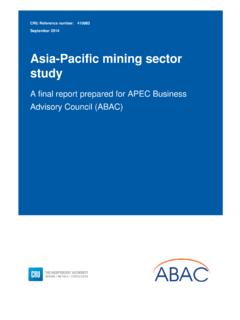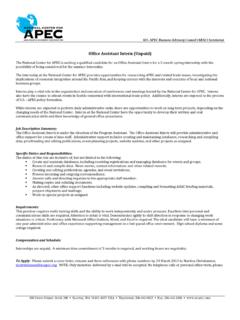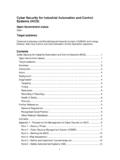Transcription of WHAT IS APEC AND WHAT CAN IT DO FOR …
1 what IS APEC AND what CAN IT DO FOR BUSINESS ?I. what is APEC?.. APEC s APEC s First Pillar: Trade and Investment APEC s Second Pillar: Trade APEC s Third Pillar: Economic and Technical How APEC The APEC The Critical Role of Business in The APEC Business Advisory The CEO Advising APEC at the Working what APEC Does for Business (Success Stories).. what IS APEC ?APEC stands for the Asia-Pacific Economic Cooperation Forum. Today, APEC has 21members, including all the major economies of the region and some of the most dynamic, fastestgrowing economies in the world.
2 APEC members have a combined Gross Domestic Product of over$16 trillion and carry out 42% of world trade. Over the past decade, APEC has become the primaryvehicle in the region to promote open trade and economic cooperation. APEC's role has grown inrecent years in both depth and scope and now encompasses trade liberalization, business facilitation,economic and technical cooperation, youth and GREAT TOOL FOR BUSINESS: tool is available for businesses to access the wealth of practical informationavailable within the APEC website. Please check out the portal An on-going project to complement the site will be a Portal Hub.
3 You will also finduseful the publication; APEC Getting Results for Business. Find it in theVirtual Library and at 's BackgroundAPEC was established in 1989 in Canberra, Australia with 12 members. Its origins lay in thedesire of the founding members to promote economic growth, foster and strengthen trade, andimprove living standards in the Asia-Pacific region. APEC started with a modest program of sectoraland trade initiatives. From the beginning, APEC has seen itself not as a grouping of countries, but ofeconomies, the term emphasizing that the organization discusses economics, not politics.
4 It was alsoestablished as a loose consultative forum, with no organization structure or a large bureaucracysupporting it. Indeed, even today, the APEC Secretariat, which is located in Singapore, includesonly 20 diplomats seconded from APEC member economies in addition to 20 locally hired was in 1993 that an annual meeting of APEC Leaders became a regular feature of one year after this first meeting, which was held in the , APEC Leaders took anotherhistoric step at their meeting in Bogor, Indonesia. At this meeting, the Leaders declared a bold goalof creating the world's largest area of free trade and investment by 2020.
5 Within APEC, thischallenge became known as the "Bogor Goals." Under the plan, developed economies wouldachieve free trade by the year 2010 and developing economies would follow in 2020.[APEC's 21 members today are: Australia; Brunei Darussalam; Canada; Chile; the People'sRepublic of China; Hong Kong, China; Indonesia; Japan; South Korea; Malaysia; Mexico; NewZealand; Papua New Guinea; Peru; the Philippines; Russia; Singapore; Chinese Taipei; Thailand;the United States; and Viet Nam.]HOW BUSINESSES CAN GET INVOLVED IN APEC:-- Contact Richard Eason at the APEC Secretariat.
6 (Tel: 65-276-1880; Fax: 65-276-1775; E-Mail: OR-- If you are interested in the specific activities of an APEC working group, task force,or other APEC group, contact directly the program director for that group. Check theAPEC Secretariat website at Or for acomprehensive list of the working groups and task forces and the name and contactinformation of the relevant their meeting in Japan in 1995, the Leaders approved what became known as the OsakaAction Agenda. Under this approach, APEC established three central pillars to its cooperative work:trade and investment liberalization, trade facilitation, and economic and technical cooperation.)
7 Amore detailed discussion of these three pillars appears below. Building on both Bogor and Osaka,the next year, the Leaders endorsed a "Manila Action Plan." In effect, this Action Plan put the fleshon the bare bones of both Bogor and Osaka. It outlined the trade and investment liberalization andfacilitation measures needed to reach the Bogor Goals. It also established a system of collective andindividual action plans which detail the paths by which economies will reach the Bogor describing any further what APEC is, it would be useful to make clear what it is is not: a formal trade agreement like the North American Free Trade Association (NAFTA); a European-style "common market," a rules-based organization like the World Trade Organization (WTO); a policy think tank group like the Organization for Economic Cooperation and Development (OECD).
8 APEC's First Pillar: Trade and Investment LiberalizationThe first pillar is critical for APEC's ability to achieve its Bogor Goal of free trade in theAPEC region by the year 2020. It works on the basis of unilateral liberalization, which means thateach APEC member voluntarily agrees to liberalize in a particular area of trade and has developed a tool for achieving this pillar: individual action plans (known by the acronymIAP). All APEC economies are required to prepare and regularly update these IAP includes details on the 15 sectors specified by the Osaka Action Agenda.
9 They include thefollowing areas: tariffs non-tariff measures services investment standards and conformance customs procedures intellectual property rights competition policy government procurement rules of origin dispute mediation the mobility of business people implementation of outcomes of the Uruguay Round of trade talks and information gathering and addition to each IAP describing what APEC members are doing in these areas, there areworking-level groups within APEC which work towards making further progress in each of the 15areas. APEC has made these IAPs more accessible to business by simplifying formats and creatingelectronic IAPs.
10 These "e-IAPs became fully operational in November 2000. In addition to theIAPs, APEC members work together collectively in these same areas through the use of CollectiveAction Plans, known as 's Second Pillar: Trade FacilitationEssentially, trade facilitation is aimed at making doing business in the region easier and lesscostly. Although work in this area continues on a broad front, APEC has already made substantialprogress in many areas including standards, customs, electronic commerce, business travel,telecommunications, energy, fisheries, and government procurement.


